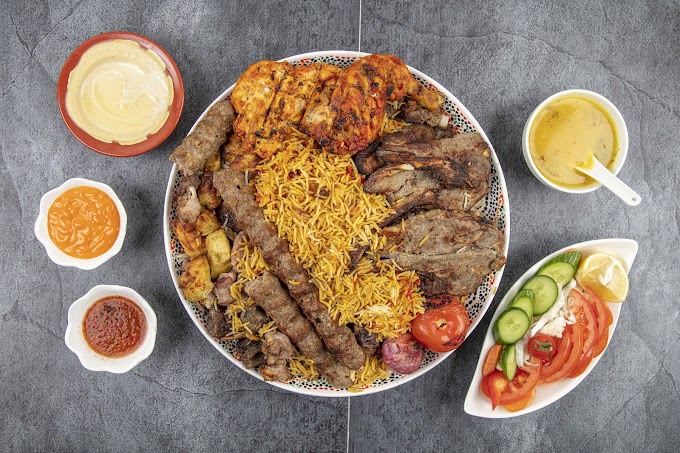Fresh ingredients, vivid flavors, and centuries-old customs are all celebrated in Lebanese cuisine. Lebanese cuisine has a rich and varied history that is worth discovering, despite frequently being overlooked by its more well-known neighbors, like Greek or Turkish cuisine. Lebanese cuisine offers something for every palate with its diverse range of vibrant dishes and exquisite harmony of savory and sweet flavors.
A Universe of Tastes: What Is Special About Lebanese Food?
Fundamentally, Lebanese cuisine blends elements from the Mediterranean, the Levant, and ancient civilizations to reflect the nation's own history and culture. With a focus on fresh vegetables, olive oil, herbs, and lean proteins like lamb, poultry, and shellfish, Lebanese cuisine is frequently flavorful but light. From warm and savory to acidic and lemony, the food is renowned for its diverse range of flavors. Most recipes, whether they are grilled meats, warm dips, or crunchy salads, are built around fresh ingredients.
The Mezze is the centerpiece of Lebanese cuisine.
The mezze, a group of tasty little dishes that are usually served as appetizers or shared plates, is one of the most recognizable aspects of Lebanese cuisine. In a single meal, diners can sample a wide range of flavors thanks to these sharing plates. Mezze meals that are popular include:- Hummus: A common accompaniment to pita bread or as a component of a larger mezze dish, hummus is a smooth mixture of chickpeas, tahini, garlic, and lemon juice.
- Tabbouleh: A light salad consisting of lemon juice, tomatoes, bulgur, and parsley. The fresh and zesty flavors are perfectly balanced.
- Baba Ghanoush: A smokey dip consisting of garlic, tahini, and roasted eggplant. It goes very well with other mezze dishes because of its rich flavor and creamy texture.
- Falafel: Crispy on the outside and soft on the inside, falafel are deep-fried chickpea patties seasoned with herbs and spices.
- Labneh: A strained yogurt cheese, is frequently served with za'atar (a mixture of sumac, sesame seeds, and thyme) and a drizzle of olive oil. It's creamy and tangy.
The simplicity, freshness, and flavor of Lebanese cuisine are reflected in these meals. They promote a feeling of camaraderie around the dinner table and are intended to be shared with friends and family.
Main Dishes from Lebanon: Tasty and Filling
Most Lebanese meals have mezze as the main course, but the main courses are equally enjoyable. A few to attempt are as follows:- Kebabs: Some of the world's greatest kebabs are Lebanese. Usually made with chicken or lamb, they are marinated in a spice mixture and then expertly grilled. These kebabs are a filling and tasty option that may be served with rice, vegetables, or flatbread.
- Fatteh: Warm pita bread, chickpeas, yogurt, and pine nuts combine to make fatteh, a filling dish that combines a lovely array of flavors and textures.
- Kibbeh: Known as the national meal of Lebanon, kibbeh is made with bulgur wheat, onions, and spiced ground meat, typically lamb or beef. You can serve it.
- Shawarma: is a common dish in the Middle East, but Lebanese shawarma is particularly tasty. It is made with marinated beef that is slow-cooked on a vertical spit and served with pita, pickles, and garlic sauce.
Desserts from Lebanon for a Sweet Finish
Without a sweet dessert to cap off the meal, no Lebanese supper is complete. Nuts, honey, and exquisite pastries are staples of Lebanese desserts. Among the well-liked candies are:- Baklava: A rich and decadent delicacy, baklava is layers of flaky pastry filled with chopped nuts and sweetened with honey syrup.
- Knafeh: A sweet and savory treat, knafeh is created with melted cheese, syrup, and shredded phyllo pastry.
- Ma'amoul: During holidays and other special occasions, people frequently eat these shortbread cookies stuffed with dates, pistachios, or walnuts.
The Impact of Lebanese Food on Global Culture
Thanks to the Lebanese diaspora, Lebanese cuisine has expanded well beyond Lebanon's boundaries and is today cherished by foodies everywhere. Lebanese food has become popular in cities like New York, Paris, and Sydney, where eateries provide everything from traditional mezze to contemporary takes on traditional meals.
With so many plant-based options, Lebanese food has gained a reputation for being wholesome and filling. Given their high nutritional content and mouthwatering flavor, it is hardly surprising that foods like hummus and tabbouleh have become staples in many nations.
Conclusion: The Benefits of Trying Lebanese Food
There is something for everyone in Lebanese cuisine, which is a stunning fusion of culture, history, and flavor. Every meal offers a chance to sample the nation's diverse culinary traditions, from the well-known mezze to the filling main courses and delectable sweets. Whether you're cooking at home or dining at a Lebanese restaurant, you'll discover that Lebanese cuisine is wonderfully tasty and nutritious.If you haven't tried Lebanese food yet, this is the ideal moment to begin discovering Lebanon's mouthwatering flavors.
Further Reading
The Ultimate Chicken Shawarma Recipe: A Step-by-Step Guide to Middle Eastern Perfection





.jpg)

